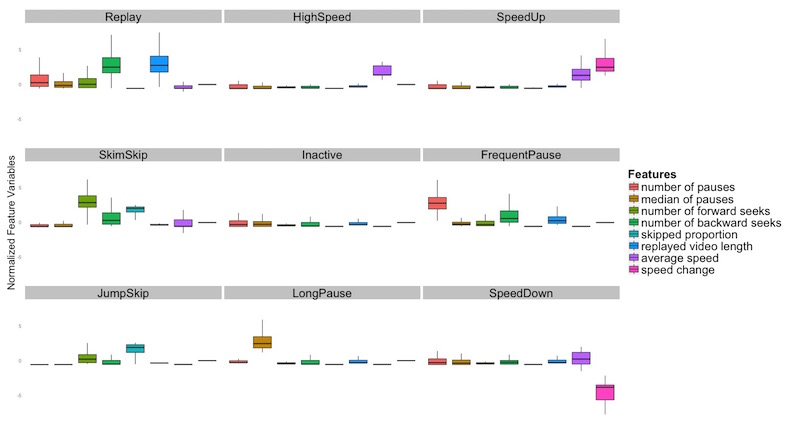Video Interaction and Perceived Video Difficulty
Video watching is the central activity in MOOC learning, so it is of great relevance for instructors to understand how students interact with videos as well as how they perceive them. Existing MOOC research literature lacks click-level video analysis in this regard.
Our research aims to fill the gap by providing an empirical investigation with two research questions: (1) Do in-video interactions reflect students’ perceived video difficulty? (2) If yes, then how is the perceived difficulty related to different types and intensities of interactions?
We conducted a survey with one question: How easy was it for you to understand the content of this video? The survey was shown as an interlaced quiz at the end of each video in two engineering MOOCs offered by our university on Coursera. The options from “Very Easy” to “Very Difficult” were coded on a Likert-scale from 1 to 5. Our research methodology was to firstly categorise the video clickstream dataset into different profiles based on the type of interactions contained in the video sessions, followed by an investigation of the relationship between each type of video interaction and the perceived video difficulty.
Key findings from our study include:
(1) A video session may start with different speeds inherited from the previously watched video. We find the initial speed negatively correlates with the perceived video difficulty. The videos started at 0.75x speed are perceived to be 0.37 (on a 5-point Likert scale) more difficult than those started at 2.0x.
(2) More frequent speed-decrease interactions are associated with higher video difficulty, while the number of speed-increase interactions does not show significant correlation with difficulty. However, the more the video speed is increased on average, the more the video is perceived to be easy. The effect is saturated when the amount of average increased speed reaches 0.4.
(3) More frequent pauses and longer pauses (in terms of median duration) both reflect higher video difficulty, but the frequency has a larger and more durable effect across its range, whereas the effect for pauses longer than 1 minute is not informative.
(4) Infrequent forward seeks and large amount of skipped content both relate to high perceived video difficulty. The latter finding is counterintuitive since we anticipate videos with more skipped content to be easier, which is not the case. Probably large skipping can be interpreted as “giving up” the video due to difficulty.
(5) Infrequent backward seeks and a large amount of re-watched content both relate to high perceived video difficulty. The former finding is interesting, because we anticipate that difficult video sessions might contain more backward seeks. In fact, many videos sessions with large number of backward seeks within a very short interval, indicated that students were actually searching for specific video frames instead of re-watching. So, the amount of re-watched content is a more reliable factor to indicate if students have experienced difficulty.
The findings of this paper shed some light on how video interactions reflect latent perceived difficulty of MOOC students. This would potentially help instructors identify videos that students may have trouble with. In the long run, detecting such problems and providing support to the students are likely to increase the students’ engagement with a MOOC and reduce the dropout rate.
Related Publication
How Do In-video Interactions Reflect Perceived Video Difficulty? 3rd European MOOCs Stakeholders Summit, Mons, Belgium, May 18-20, 2015. ( URL: https://infoscience.epfl.ch/record/207968?ln=en)
MOOC Video Interaction Patterns
-
number of pauses (NP)
-
median duration of pauses (MP)
-
number of forward seeks (NF)
-
proportion of skipped video content (SR)
-
number of backward seeks (NB)
-
replayed video length (RL)
-
average video speed (AS)
-
effective video speed change (SC)
With these features, we clustered video interactions collected from two EPFL MOOCs into 9 clusters and gave each cluster a name according to the distributions of the feature variables (see picture below, data beyond the end of the whiskers are not shown). Together with the videos containing no video interactions (called Passive), we obtained ten MOOC video interaction patterns.

With these patterns, we find that:
- The SpeedUp pattern reflects the lowest perceived video difficulty. On the other hand, the FrequentPause and Replay patterns reflect the highest video difficulty.
- Videos that contain “in-video” dropout are very highly likely to be revisted by the students. Those who watched the videos with FrequentPause and Replay patterns for the first time are also likely to be revisited.
- Weak students are found to have paused (LongPause and FrequentPause) more than strong students. In terms of Replay, the differences are not significant.
Related Publication
MOOC Video Interaction Patterns: What Do They Tell Us? 10th European Conference on Technology Enhanced Learning, Toledo, Spain, 15-18, 2015. ( URL: https://infoscience.epfl.ch/record/208845?ln=en)